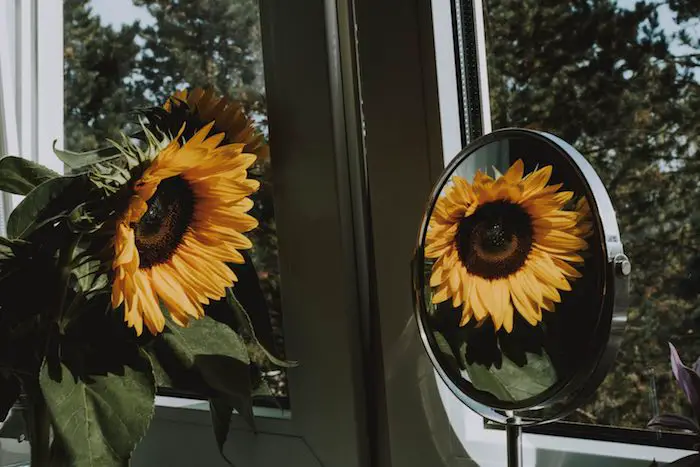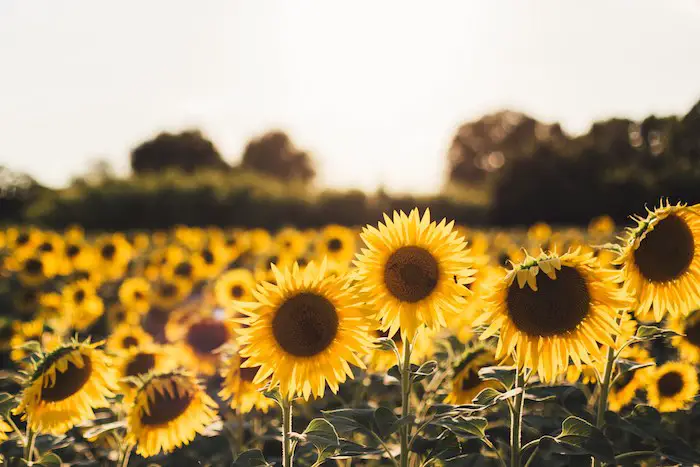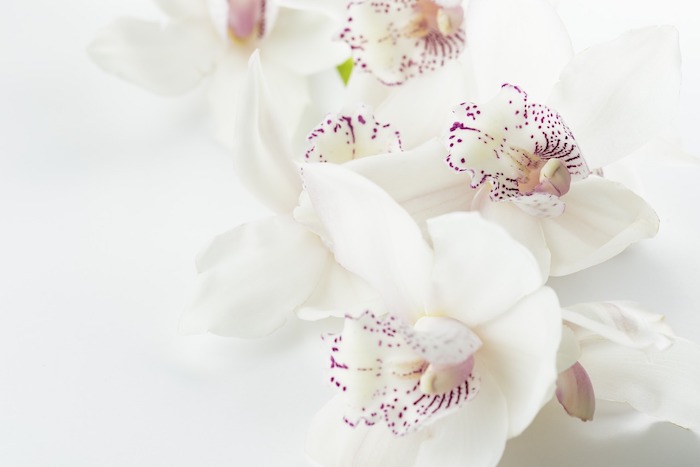Nothing replicates the spirit of Summer more than a bunch of lively and bright yellow sunflowers. Many people believe that they grow only in a front garden or back yard, but that’s not true. Interestingly, you can grow sunflowers inside your home to sprinkle a bit of summer indoors.
If you are not already aware then let me tell you that indoor sunflowers are a trend these days. As these flowers have a high nutritional value; they are highly preferred by organic food lovers. Their head full of seeds are not only tasty but the seeds can also be used to replant every year.
We believe that the lack of outdoor space should not be a reason to not have sunflowers blooming in your balcony or window sill. So, if you are looking for the best way to grow sunflowers indoors for their visual appeal or nutritional attributes, you will find all information here.
Select The Correct Indoor Variety
First things first. To start with, you will first need to choose the right variety of sunflower plant that is attuned to grow indoors. Most indoor gardeners choose a dwarf variety to grow sunflowers in the balcony due to their compact size, ease of cultivation, and low maintenance.
The dwarf varieties will typically grow less than 2 feet tall, and produce bright yellow blooms with a dark center. Some of these species produce flowers that yield edible seeds that are a rich source of Vitamin E and B. Here are the most common varieties to choose from:
- Pacino: This variety can reach up to two feet and it is capable of producing a rich bunch of sunflowers with bright yellow petals and a yellow center.
- Big Smile: This plant can grow to a maximum height of eight inches and it produces just one flower with bright yellow petals and a black hub in the center
- Valentine: This is a branching variety of sunflowers that come with yellow petals and a light middle. The plant may grow up to 3 feet tall.
- Jade: This is the tallest of the dwarf varieties of plants and they can achieve a maximum height of 4 feet. The flowers bloom pretty quickly with the cream-colored center and greenish petals. These flowers are used for decorative arrangements as the seeds are not edible.
- Teddy Bear: This variety produces 1-foot size plants that come with orange and yellow petals. When the plant achieves bloom time, they produce flowers measuring 4-inch each and they can expand with 4-6 extra surrounding flower heads.
Get The Perfect Pot Or Container
When growing in pots, the seeds or seedlings of dwarf varieties will grow best in a small 12-16 inch container. The tall varieties will need a planter size of at least 5 gallons. The sunflower plants prefer the stability that comes from staying in the same container with soil mixed with organic compost.
The plants do not appreciate relocating from one pot to another. We suggest that you plant only one seed per pot and let it stabilize and grow to a certain height. When the plants mature enough, you may transfer it to a bigger container with more space for the roots to breathe and spread out.
Steps To Plant Seeds Or Seedlings

While many people prefer to grow sunflowers from seedlings, we think they are easier to grow from seeds. If you want to plant them directly, we suggest doing it before the last expected spring frost as the plants can withstand a chill or two.
When the growing season is long, wait until the soil temperature in the pot reaches 55 to 60 degrees F. Sunflowers grow best in a slightly acidic to fairly alkaline soil (ideal level is pH 6.0 to 7.5).
If you are growing from seeds, they will need abundant warmth and sunshine in order to germinate. The seeds should be carefully planted in the seedlings tray and placed in the sunniest position of the house.
Here are the steps you need to follow:
- Plant the sunflower seeds in individual containers that have drainage holes and add a well-drained potting mix to them. This provides a favorable environment for the plants to grow faster and also prevents water from pooling inside the container.
- Keep the sunflower plant in an area where it can be exposed to about six hours of sunlight per day. An east or south-facing window is the ideal choice. The soil temperature should be maintained at a favorable 70-75 degrees at the time of germination.
- In about a week, you should be able to see the first leaves shoot out of the seeds and the growth is pretty fast if the container is placed in front of a south-facing window. When the light is not sufficient, use supplementing grow lights specifically designed to help in seed germination.
- Make sure you do not change the location of the pot until the plant is properly established. It can then be replanted to a bigger pot that comes with a wider bottom. If you see a new plant growing tall with famished leaves, you may need to discard them altogether as they will never grow to the actual size or produce any seeds.
Watering Requirements For Indoor Sunflower
Keep a tray or saucer beneath the pot and make sure you hydrate the soil well with a watering can until water runs out from the drainage holes. Be careful to not get the foliage wet, and discard the drained water. You must water only when the top inch of the soil becomes dry.
The seeds will require at least 2 gallons of water per week while germinating. Within 7-10 days, you can expect to see the sunflower seeds grow into small seedlings. Continue to water the seeds regularly to keep the soil well hydrated. You must aim at maintaining a moist, not soggy soil.
When the plants grow naturally outdoors, frequent rainfalls are adequate to help them achieve the correct height and shape. For indoor plants, you need to water regularly to replicate the natural environment within the house. Remember to water the plant regularly 20 days before and after flowering to ensure optimum growth.
Supporting The Plants As They Grow
If it’s too windy where you live, insert a bamboo or wooden stake in the container to protect the plants. Sunflower plants, even if they are dwarf in size, tend to get heavy on the top when the plant achieves full bloom. Hence, we suggest that you tie the main stems loosely using an elastic cord or soft twine.
Make sure the stakes are never placed directly into the pot or else they may damage the root. If you want to encourage bushy growth, pinch the growing tip to get more branches. However, if you prefer a single large bloom then avoid pinching the tip.
Feeding Fertilizers
Although sunflower plants do not necessarily need additional fertilizers to grow, they can make the flower heads look bolder and brighter. We suggest that you start with a high-nitrogen liquid fertilizer and feed the plants at least once a week. Switch to phosphorus during the blooming period.
The potted plants find it difficult to draw fertilizer from the ground, so consider using a liquid fertilizer for blooming plants. Dilute the fertilizer as mentioned and add to the pot. Make sure you do not overfeed the plant with fertilizers or else the stems may break.
Diseases and Pests In Indoor Sunflowers
Just like the naturally grown sunflowers are prone to acquiring many types of plant diseases, indoor varieties are also vulnerable. However, the indoor varieties do not get attacked by squirrels, birds, and other animals. Keep them safe from pets at home.
While they are protected from animals and insects when growing indoors, make sure you keep them in a sunny location to avoid fungal infestation. Too much moisture on the plants may even lead to the growth of fungus or mildew.
Transplanting Inhouse Sunflower Plants Outdoors (Optional)

Some people choose to grow their sunflowers indoors when the outside climate is not conducive to their growth. When the weather becomes warm again for the plants to thrive, you may consider transplanting them to your garden.
If you choose to let the plant stay in the pot, protect the top layer of the soil from pests attack by using a wire mesh. In case you choose to transplant directly to the soil and cover the top layer with gravel to moss to reduce attack by squirrels or birds.
Harvesting At The End Of Season
When a growing season comes to an end, the plant will wilt and the petal will begin to fall. If you cultivate sunflowers indoors for their seeds, the best way to harvest is to allow them to die slowly and naturally.
You may use a sharp pruner or scissor to cut off the head part of the plant. It is located nearly 6 inches below the main flower head. Put it in a container to gather the loosening seeds. To collect seeds just move your hand over the dried head or use a fork to pull them off the plant.
As the flowers may not look attractive, you may consider moving the plant to another location as long as they get enough warmth, until the seed achieve their edible size. After the harvesting is complete, you may save some seeds to replant the next year.
Always store the harvested seeds in an airtight container and keep it in a cool and dry place, until you are ready to plant it next season. The rest of the plant can be discarded because they cannot bloom again.
Tips To Take Care Of Indoor-grown Sunflowers
Growing sunflowers indoors may seem like a tough task but it’s actually much easier than you think. Here are a few tips to remember to take care of the indoor plants:
- Always plant the seeds or seedling at least 12 inches deep in well-fertilized soil. Use some form of organic matter in the soil to improve growth.
- Keep the pots and containers in a sunny location of the house, preferably facing the south window. We suggest that you minimize the number of pot changes and location transfers.
- Apply a diluted liquid fertilizer around the base of the sunflower plant throughout the growing season, in every 2-3 week intervals to encourage a healthy growth.
- When growing more than one plant, keep the containers in close proximity to each other as sunflowers are known as social plants. You can distance them when the plants grow taller and bushier.
- When the plant reaches two feet height, let it stabilize and support with the help of stakes. If you are using a small pot or container, you may put stakes behind the plant and secure them with outside structures such as a wall or another planter.
- Remember to water regularly during the growing season as sunflowers are thirsty feeders, especially when grown indoors. Cover up the top layer with gravel or mulch, leaving some gap near the stem to allow it to breathe well.
- If you are growing the plants completely indoors, you don’t have to worry about pest control or weeding issues. However, you will need to keep them safe from pets if any.
Related Questions
Where can I find sunflower seeds to start growing
You may get the good quality sunflower seeds from a garden center or your local nursery. The ones available at the grocery and convenience stores are usually the edible ones for consumption, not for growing. After the seeds are roasted, they will not sprout.
If you are looking for rare varieties of sunflower seeds, check them online. The dwarf varieties mentioned above are best suited for indoor growing. After harvesting the seeds, keep them enclosed in an airtight container, inside the refrigerator.
How long do sunflowers take to bloom?
Most of the sunflower varieties are fast-growing and they mature in about 85 to 95 days. The large varieties will grow more than 16 feet in height, while the dwarf ones meant to grow in pots and containers will achieve a maximum height of 16 feet. The flower heads may be more than 12 inches in diameter.
What is the best time to grow sunflowers
The best time to sow the seeds is usually after the spring frost has passed and the soil has warmed. However, if you are growing them indoors, you don’t need to worry much as you can use grow lights to create a favorable environment for growth.
If you want to grow sunflowers in your balcony, the best time is between April and mid-July. In the southern regions, the ideal period in mid-March or early April.
How much light do they need
When growing indoors, keep them in the sunniest spot in the house. The best growing locations are those that get at least 6 to 8 hours per day. It may not be feasible to get that amount of sunlight indoors, so supplement with fluorescents or LEDs.
See also: How Much Light Do Succulents Need
What’s the right way to cut sunflowers for bouquets
If you want to create an indoor sunflower bouquet, cut the main stem before the flower bud opens up to encourage it to spread out in the sides. We suggest that you cut the stems early morning as harvesting them mid-day may cause the flowers to wilt.
See Also:
20 Best Etsy Plant Shops
Do All Plants Improve Air Quality (Here’s The Answer)
4 Best Pruning Shears For Indoor Plants
A Zen Garden: All You Need To Know


